This was a week of highs and lows across the Himalayas. On Everest, three Sherpas lost their lives in the Icefall. The season’s first 8000 meters summits occurred on Saturday, April 16, on Annapurna. Everest Base Camp is filling up as permits top 300.
Last Week
Tragic Deaths
Tragedy struck on Wednesday, April 12, 2023, when three sherpas working for Imagine Nepal died in the upper Khumbu Icefall. They were part of a twenty-five-person team carrying supplies to Camp 2, where they would fix the ropes to the summit.
Imagine Nepal issued this statement:
With great sadness, we must share the devastating news of the demise of three of our Sherpa brothers, Dawa Tseri Sherpa, Pemba Tenzing Sherpa and Lakpa Rita Sherpa.Our hearts are heavy with grief as we mourn the loss of these brave brothers who dedicated their lives to guiding and supporting climbers. We extend our deepest sympathies and condolences to the families and loved ones. We ask for your understanding and respect during this difficult time. We will continue to support you wherever we can.These couple of days, we relentlessly tried to recover our brothers’ bodies but failed. Though the loss profoundly saddens us, we know that the world will go on, and we will continue to carry on the tasks we are assigned for.
At the top of the Icefall, the underlying ground drops off sharply, so the glacier, when it moves across that area, picks up speed and gets extremely jumbled. I’m told by Garrett Madison of Madison Mountaineering that the Sherpas said a few days ago that section was “sketchy”
Maddison told me, “our Sherpas had been telling me for a week or so before the collapse that the icefall seemed very dangerous above the football field..” The Icefall Doctors will need to re-route the path between Base Camp and Camp 1, so climbing will stop for a few days.
My sincere condolences to their families, friends, and teammates.
Annapurna Summits
Statistically, Annapurna has the highest death rate of all the 8000ers. However, in the past several seasons, Nepali guide companies have shown how to tame this deadly beast. In a formula used for decades on Everest, the same process is being applied to the other high peaks.
Using a strong group of Sherpas to fix the route and create a boot path, clients now follow the pack using supplemental oxygen to the top. What used to be a 25% death rate has dropped into the high teens now. Still a dangerous climb with plenty of objective dangers like avalanches, so only experienced climbers should attempt it with qualified support.
On Saturday, April 16, Annapurna, at 26,545 feet, a seven-person rope-fixing team with five clients was the first to reach the top. Also summiting was Qatari royal family member Sheikha Asma Al Thani with Elite Expeditions. Another twelve people reached the summit today, Sunday, April 16.
Karrar Haidri, Alpine Club Of Pakistan Secretary, said that 21-year-old Pakistani mountaineer Sajid Ali Sadpara summited with this statement:
Congratulations to Sajid Ali Sadpara and the Seven Summit Treks team for successfully reaching the summit of Annapurna 8091m. Sajid Ali Sadpara, a Pakistani mountaineer, is renowned for his feats in high altitude mountaineering. He is the son of the late Ali Sadpara, who was also a renowned mountaineer with several successful ascents of peaks above 8,000 meters. Annapurna, the tenth highest peak in the world, is known for its technical difficulties and high fatality rate, making it a challenging climb even for experienced mountaineers.
Canada, Jill Wheatley, who is 70% visually limited, summited with Imagine Nepal’s Sherpa Pemba Chhiri Sherpa. She is one of several females going for all fourteen 8000ers. She has K2, Kanchenjunga, Makalu, Dhaulagiri, Manaslu and Broad Peak, and now Annapurna. She hopes to get Everest and Lhotse this season.
Nepal issued fifty-four Annapurna climbing permits, including sixteen female climbers, to foreigners this year. As of April 16, the Ministry of Tourism has issued 319 permits for Everest, with 17% female climbers. There are sixty-one for Lhotse. I expect around 400 for Everest. The top three countries on Everest, as expected, are the US at fifty-nine, China at forty-eight and India at thirty-one. For all of Nepal’s mountains, there are currently 743 permits issued.
Next Week
EBC has many teams have arrived at EBC. They will take a few days to adjust further to the 17,500-foot altitude. Some will return down valley to Lobuche for more acclimatization and to reduce rotations through the Icefall by at least one.
The Icefall Doctors will repair the route disrupted by the collapse that took three lives, so I don’t expect a lot of movement above Base Camp until midweek. Teams will spend their time at base camp reviewing skills and practicing on a nearby obstacle course. They will scale ice walls using their crampons and a jumar on a rope, cross ladders and practice crossing anchors. All this will become second nature as they make their climbs toward the summit. Also, many teams will have their puja.
First Days at Everest Base Camp
A rough estimate is that about 300 foreigners plus the same number of support staff are already at Everest Base Camp (EBC) this weekend. Over the next ten days, this will swell to 1,000 people, including foreigners, cooks, Sherpas, and staff
They mostly let their bodies catch up to the altitude for the first few days, around 17,500′. After that, many are seeking to buy their EverestLink access card. This service provides relatively high-speed WiFi at base camp. Note, there is no connection above EBC, i.e., at Camp 1 or on the summit for WiFi.
The mobile phone provider, NCELL, does provide service to EBC from their antennas at Gorak Shep. But you have to wander around to find a reliable 3G signal; a voice connection is easier to find. However, NCELL is upgrading its network, so 4G may be more reliable at EBC and reach the summit this season.
Many commercial guides will set up a training course where the Sherpas and guides will review basic skills with their members. The Sherpas, cooks, and staff will be busy. They will build sleeping tent platforms, organize the kitchen, find a good water source, and build rock walls to mark their camp. This last part also keeps wandering yaks from exploring open tents!
Water is always an issue at EBC. While plenty of snow and ice is available, getting access to clean water is a massive job. Each year, a ‘cook boy’ will have the job of carrying a large blue barrel to the closest water, usually some tiny pond of melted ice. He fills up the barrel and hauls it back to the cook tent. It is brought to a boil before using it for cooking and drinking. A few guides brought pumps to transfer the water this year, but they must be very close to the source. 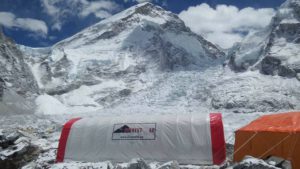
With 1,000 people and yaks, Zos, and mules wandering around, you never drink water unless it has been boiled and treated.
Another feature of EBC is the location of EverestER. This volunteer team of doctors provides medical services to all foreigners for the bargain price of around $100 each, plus unlimited free services for Sherpas, porters, cooks, and any Nepali. Their service is underwritten thru donations. To get a feel for how the season is going, we can see how many people they treat as a good indicator of EBC health.
Dr. Luanne Freer founded the all-volunteer service in 2003. Today they are part of the Himalayan Rescue Association(HRA), a non-profit organization formed in 1973 to reduce casualties in the Nepal Himalayas. Last spring, EverestER treated 364 patients, including 268 Nepalis.
Lobuche Acclimatization
A program used by many guide companies to reduce the risk of climbing from the south side is to use the 20,000-foot trekking peak, Lobuche East, for acclimatization. This climb will eliminate one rotation thru the Icefall. The altitude is about the same as between Camps 1 and 2 in the Western Cwm. IMG, CTSS, and other teams have used this peak for years.
Yesterday, April 15, one of the IMG teams climbed to the summit and is already back at Lobuche Base Camp. The climb takes a bit over four hours, and we have reports of a “hard but good day.” You get amazingly clear views of Everest, Lhotse, Nuptse, Makalu, and more from the summit.
Adjustments
The story is that everyone is adjusting to their new environment. Some to the new food, others to the thin air, and a few are rethinking their climbing objective.
The trek-in was a time to reflect on why you were there and if you were ready. Almost everyone has a moment of doubt; that is normal. When you begin to feel the thin air at 16,000 feet or stop to take a breather on a small hill, those doubts enter your mind.
But it is OK. The body is adjusting. With thin air, the body responds by breathing faster. So in a contradictory moment, when you feel like to are not ready, it is just the opposite; your body is busy making the necessary adjustments. In other words, the business of climbing Everest will be in full motion.
The Puja
Your tent, the one in the middle of a row of seven, seems to catch the first rays of the sun. This is good as it quickly warms your cocoon. Then you remember, “It’s Puja morning.” So you grab your “sharps,” boots – anything that will touch the ground, touch Sagarmatha, touch Chomolungma.
You head to breakfast. It’s quick this morning as the Sherpas have been preparing for hours. The Lama spent most of the night cooking tiny pastries that adorns the Alter. The Lama hiked in from a village to perform the ceremony. He does this for your team and many others. He gets several thousand rupees for all of these – not a bad gig if you can get it. But cynicism aside, his demeanor, tone, and reverence give you pause halfway through the ceremony.
The Sherpas seem to have a high level of energy this morning. They move at a quickened pace that you rarely witness.
A large stone Stupa has already been erected primarily to hold the flag pole and a picture of the Dali Lama. Blankets are laid out for the climbers to sit on during the long ceremony. The Sherpas are busy stringing the multi-color prayer flags across the camp, and all are centered on the flag pole at the Stupa.

Soon the sounds of the fluttering flags cover the entire camp. Each flag has a different meaning: yellow-earth, green water, red-fire, white-air, and blue-space.

More Sherpas are busy starting a small juniper fire. The smoke will cover the entire camp. It is hazy and fragrant. It marks the beginning of something special. This is not the last time you will see this smoke. Every time before leaving Base Camp, each climber and Sherpa will pass by this same spot, letting the smoke from the juniper boughs cover them. More on this later.
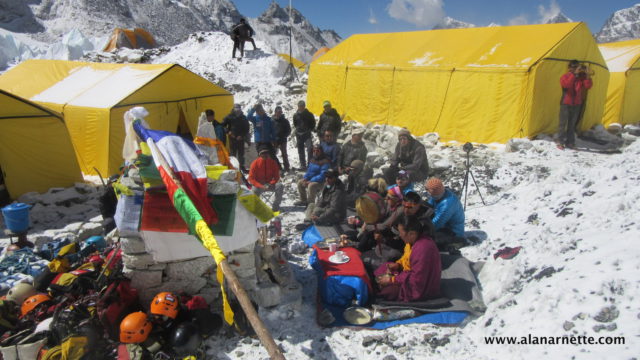
Everyone takes their place on the blankets after resting their climbing tools against the Stupa. Part of the ceremony is to ask forgiveness for hurting Chomolungma with the sharp points of the tools. But the most important part is to ask permission to climb the mountain and for safe passage. “Forgiveness, permission and safety,” you think these are qualities we should express every day.
The Lama begins with a low chant as he reads from the 300-year-old Tibetan prayer book. Everyone soon quiets down as the chanting occupies the entire team of Sherpas. Soon, a Sherpa laughs, others smile, and the environment is respectful but not overly serious.
One Sherpa begins to walk around offering snacks and Chiang to everyone. You shake your head, not wanting to drink any alcohol. It’s OK not to drink the firewater: the Sherpa smiles and moves on. Everyone is now relaxed as the Lama continues his chanting. A small black bird lands on the top of the flag pole, a Himalayan Chuff; it signifies good luck. Everyone smiles.
Without notice, the Lama and Sherpas performing the ceremony stand up. Another low baritone sound emerges. It raises and lowers, rises and lowers, then on a mysterious signal, everyone takes their handful of rice and throws it into the air three times, saying another mysterious chant. You have no clue, but it doesn’t matter. Now everyone joins in doing their best imitation of a Tibetan chant. Listening carefully, you think the Tibetan ancestors would be pleased.
Thinking the Puja is over now that rice has been thrown in the air (actually, it was to ward off evil spirits), the puja moves to the next chapter. The Lama stops his chanting. Everyone stands up and begins to wander. But there is a system to this ceremony you simply don’t understand.
Suddenly, there is a commotion as a Sherpa with a handful of brown powered, barley flour, spreads it all over your face. You really are confused, but it is a good thing as laughter abounds. It symbolizes a white beard and long life. Soon everyone is smearing barley flour on one another.
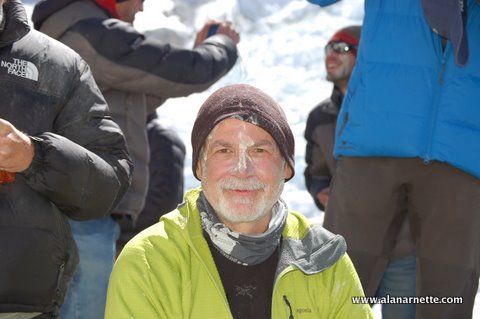
Then something occurs you might never understand. One of the senior Sherpas opens the bottle of Jonnie Walker Whisky (no ‘e’ in this Scotch!). He pours a wee bit of the whisky into the cap and offers it to one of your teammates. He gingerly takes the cap and drinks. The Sherpa repeats this two more times. But as you saw the Sherpas do it, before they drink, they put one finger into the cap, barely dabbing their fingertip and then throwing it over their left shoulder three times. It’s a mystery.
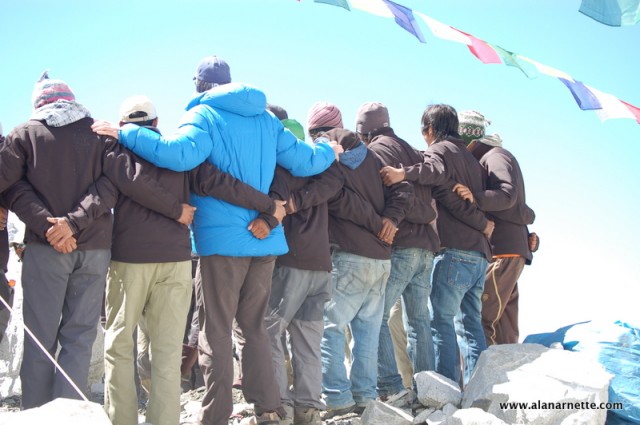
More laughing, and then the dancing starts. The Sherpas, with arms around one another, form a line and begin a dance that would make the Rockets proud. The climbers and trekkers join in. Another Sherpa walks around with the bottle of whisky, carefully pouring a small amount into the bottle cap; most everyone has a taste. More laughs and smiles.
The ceremony ends with a whimper as people drift away, deep in their thoughts about what the ceremony meant to them.
You return to your tent, emotions fully engaged. Clearly, for the Sherpas, it is an homage to Miyolangsangma, the Tibetan Goddess of Mountains, who lives on the summit of Everest. For others, it was a simple ceremony that symbolized the beginning of the climb. And for others, it was entertainment, dismissing the beliefs of others.
You slowly let the ceremony seep in. The sounds, the visions, the seriousness the Sherpas took in placing the prayer flags, building the Alter, placing the tokens, sharps, and pictures. The sound of the Lama reciting the Buddhist prayers and the simple quiet between the moments.
No, you didn’t drink the Johnny Walker. But, yes, you turned your head and nodded when the Sampa was offered as an indication of long life. And yes, you felt the connection between what many consider commercialization and the reason so many people are here to climb Chomolungma.
Perhaps your true reason for your “why” is revealed. And yet, you retreat to the simple answers given before you left home, the reason you told yourself. And the veneer is slowly peeling away.
Climb On!
Alan
Memories are Everything
The Podcast on alanarnette.com
You can hear #everest2022 podcasts on Spotify, Apple Podcast, Google Podcasts, Pocket Casts, RadioPublic, Anchor, and more. Just search for “alan arnette” on your favorite podcast platform.
Why this coverage?
I like to use these weekend updates to remind my readers that I’m just one person who loves climbing. With 37 serious climbing expeditions, including four Everest trips under my belt and a summit in 2011, I use my site to share those experiences, demystify Everest each year and bring awareness to Alzheimer’s Disease. My mom, Ida Arnette, died from this disease in 2009, as have four of my aunts. It was a heartbreaking experience that I never want anyone to go through; thus, my ask for donations to non-profits where 100% goes to them, and nothing ever to me.
![]()

Summit Coach
If you dream of climbing mountains but are not sure how to start or reach your next level, from a Colorado 14er to Rainier, Everest, or even K2, we can help. Summit Coach is a consulting service that helps aspiring climbers throughout the world achieve their goals through a personalized set of consulting services based on Alan Arnette’s 25 years of high-altitude mountain experience, including summits of Everest, K2, and Manaslu, and 30 years as a business executive.

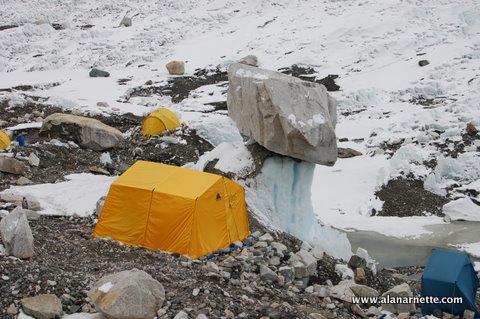
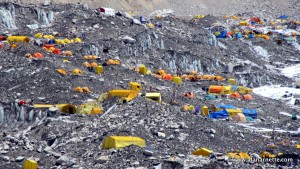
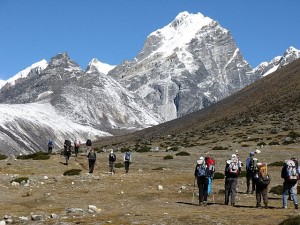


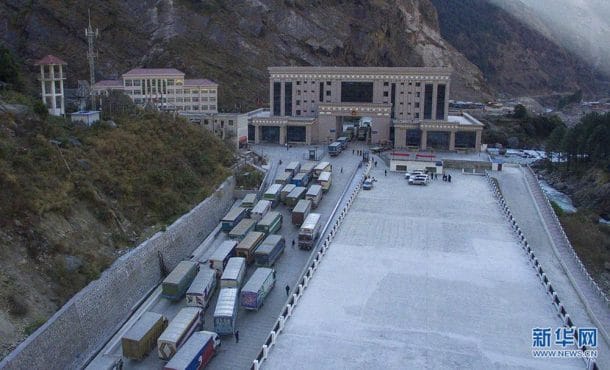
2 thoughts on “Everest 2023: Weekend Update April 16”
How can we help the families of the Sherpas who died?
https://www.thejuniperfund.org
Comments are closed.